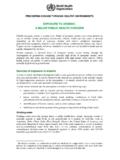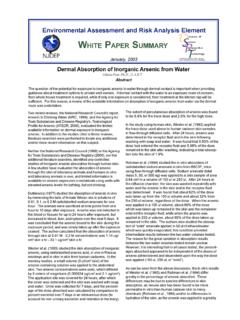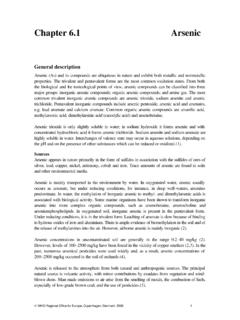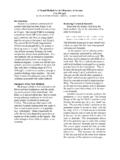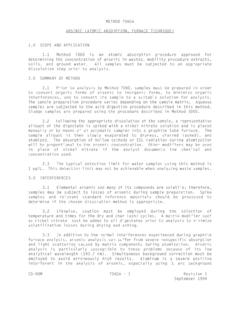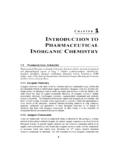Transcription of Chapter 1. Source and behaviour of arsenic in natural waters
1 1 Chapter 1. Source and behaviour of arsenic in natural watersPauline L Smedley and David G KinniburghBritish Geological Survey, Wallingford, Oxon OX10 8BB, of arsenic in drinking in natural and speciation of and of , sediments and to arsenic interactions in in reduced sediments and release from soils and sediments following of environments showing enhanced arsenic distribution of groundwater arsenic oxidising oxidising and reducing mineralisation and mining-related arsenic features of groundwater arsenic problem hydrogeochemical Source necessary geochemical hydrogeological dimension aquifer questions and further analytical methods for arsenic of groundwater the problem groundwaters get better or worse with time?
2 Under natural flow of arsenic with for locating arsenic problems in Importance of arsenic in drinking waterArsenic (As) is a ubiquitous element found in the atmosphere, soils and rocks, natural watersand organisms. It is mobilised in the environment through a combination of natural processes such asweathering reactions, biological activity and volcanic emissions as well as through a range ofanthropogenic activities. Most environmental arsenic problems are the result of mobilisation undernatural conditions, but man has had an important impact through mining activity, combustion of fossilfuels, the use of arsenical pesticides, herbicides and crop desiccants and the use of arsenic as anadditive to livestock feed, particularly for poultry.
3 Although the use of arsenical products such aspesticides and herbicides has decreased significantly in the last few decades, their use for woodpreservation is still common. The impact on the environment of the use of arsenical compounds, atleast locally, will remain for some the various sources of arsenic in the environment, drinking water probably poses thegreatest threat to human health. Airborne arsenic , particularly through occupational exposure, has alsogiven rise to known health problems in some water is derived from a variety of sources depending on local availability: surfacewater (rivers, lakes, reservoirs and ponds), groundwater (aquifers) and rain water.
4 These sources arevery variable in terms of arsenic risk. Alongside obvious point sources of arsenic contamination, highconcentrations are mainly found in groundwaters. These are where the greatest number of, as yetunidentified, sources are likely to be found. This review therefore focuses on the factors controllingarsenic concentrations in the accumulation of evidence for the chronic toxicological effects of As in drinkingwater, recommended and regulatory limits of many authorities are being reduced. The WHO guidelinevalue for As in drinking water was provisionally reduced in 1993 from 50 g l 1 to 10 g l 1. The newrecommended value is based largely on analytical capability.
5 If the standard basis for risk assessmentapplied to industrial chemicals were applied to arsenic , the maximum permissible concentrationwould be lower still. The US-EPA limit was also reduced from 50 g l 1 to 10 g l 1 in January 2001following prolonged debate over the most appropriate limit. The EC maximum admissibleconcentration (MAC) for As in drinking water is also to be reduced to 10 g l 1. The Japanese limitfor drinking water is 10 g l 1 and the interim maximum acceptable concentration for Canadiandrinking water is 25 g l many national authorities are seeking to reduce their limits in line with the WHOguideline value, many countries and indeed all affected developing countries, still operate at presentto the 50 g l 1 standard, in part because of lack of adequate testing facilities for lower recently, arsenic was often not on the list of constituents in drinking water routinelyanalysed by national laboratories.
6 Water utilities and NGOs and so the body of information about thedistribution of arsenic in drinking water is not as well known as for many other drinking-waterconstituents. In recent years, it has become apparent that both the WHO guideline value and currentnational standards are quite frequently exceeded in drinking-water sources, and often unexpectedly , arsenic and fluoride are now recognised as the most serious inorganic contaminants indrinking water on a worldwide basis. In areas of high arsenic concentrations, drinking water providesa potentially major Source of arsenic in the diet and so its early detection is of great arsenic in natural Aqueous speciationArsenic is perhaps unique among the heavy metalloids and oxyanion-forming elements ( , selenium, antimony, molybdenum, vanadium, chromium, uranium, rhenium) in its sensitivityto mobilisation at the pH values typically found in groundwaters (pH ) and under bothoxidising and reducing conditions.
7 arsenic can occur in the environment in several oxidation states3(-3, 0, +3 and +5) but in natural waters is mostly found in inorganic form as oxyanions of trivalentarsenite (As(III)) or pentavalent arsenate (As(V)). Organic arsenic forms may be produced bybiological activity, mostly in surface waters , but are rarely quantitatively important. Organic formsmay however occur where waters are significantly impacted by industrial toxic trace metals occur in solution as cations ( Pb2+, Cu2+, Ni2+, Cd2+, Co2+, Zn2+)which generally become increasingly insoluble as the pH increases. At the near-neutral pH typical ofmost groundwaters, the solubility of most trace-metal cations is severely limited by precipitation as,or coprecipitation with, an oxide, hydroxide, carbonate or phosphate mineral, or more likely by theirstrong adsorption to hydrous metal oxides, clay or organic matter.
8 In contrast, most oxyanionsincluding arsenate tend to become less strongly sorbed as the pH increases (Dzombak and Morel,1990). Under some conditions at least, these anions can persist in solution at relatively highconcentrations (tens of g l 1) even at near-neutral pH values. Therefore the oxyanion-formingelements such as Cr, As, U and Se are some of the most common trace contaminants in , relative to the other oxyanion-forming elements, arsenic is among the mostproblematic in the environment because of its relative mobility over a wide range of redox is mobile as the selenate (SeO43-) oxyanion under oxidising conditions but is immobilizedunder reducing conditions either due to the stronger adsorption of its reduced form, selenite (SeO33 ),or due to its reduction to the metal.
9 Chromium can similarly be mobilized as stable Cr(VI) oxyanionspecies under oxidising conditions, but forms cationic Cr(III) species in reducing environments andhence behaves like other trace cations ( is relatively immobile at near-neutral pH values). Otheroxyanions such as molybdate, vanadate, uranyl and rhenate also appear to be less mobile underreducing conditions. In sulphur-rich, reducing environments, many of the trace metals also forminsoluble sulphides. By contrast, arsenic is perhaps unique in being relatively mobile under reducedconditions. It can be found at concentrations in the mg l 1 range when all other oxyanion-formingmetals are present in the g l 1 potential (Eh) and pH are the most important factors controlling arsenic oxidising conditions, H2 AsO4 is dominant at low pH (less than about pH ), whilst at higherpH, HAsO42 becomes dominant (H3 AsO40 and AsO43 may be present in extremely acidic andalkaline conditions respectively).
10 Under reducing conditions at pH less than about pH , theuncharged arsenite species H3 AsO30 will predominate (Figure ; Brookins, 1988; Yan et al., 2000).The distributions of the species as a function of pH are given in Figure In practice, most studies inthe literature report speciation data without consideration of the degree of protonation. In the presenceof extremely high concentrations of reduced sulphur, dissolved arsenic -sulphide species can besignificant. Reducing, acidic conditions favour precipitation of orpiment (As2S3), realgar (AsS) orother sulphide minerals containing coprecipitated arsenic . Therefore high arsenic waters are notexpected where there is a high concentration of free sulphide (Moore et al.)










